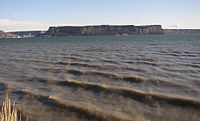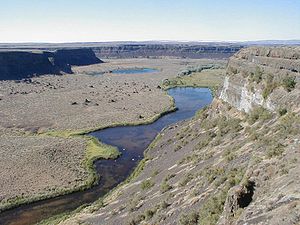Grand Coulee

The Grand Coulee is an ancient river bed in the U.S. state of Washington. This National Natural Landmark stretches for about sixty miles southwest from Grand Coulee Dam to Soap Lake, being bisected by Dry Falls into the Upper and Lower Grand Coulee.
Geological history


The Grand Coulee is part of the Columbia River Plateau. This area has underlying granite bedrock, formed deep in the Earth's crust 40 to 60 Ma (million years ago). The land periodically uplifted and subsided over millions of years giving rise to some small mountains and, eventually, an inland sea.
About 10 to 15 Ma volcanic eruptions from the Cascade Mountains began to fill the inland sea with lava. In some places the volcanic basalt is 2,000 metres (6,600 ft) thick. In other areas granite from the earlier mountains is still exposed.
Two million years ago the Pleistocene epoch began and Ice age glaciers invaded the area. They scoured the Columbia River Plateau, reaching as far south as highlands above the Grand Coulee. In some areas north of the Grand Coulee they were as much as 3,000 metres (9,800 ft) thick. Grooves in the exposed granite bedrock are still visible in the area from the movement of glaciers and numerous glacial erratics in the elevated areas to the Northwest of the coulee.
Although early theories suggested that glaciers diverted the Columbia River into what became the Grand Coulee and that normal flows caused the erosion observed, geologists now agree that it was created by glacial diversion combined with massive glacial floods from Lake Missoula. This was a glacier dammed lake with water up to 600 metres (2,000 ft) deep. The dam periodically gave way, creating the Missoula Floods and sending huge amounts of water through the Columbia Basin as recently as 18 thousand years ago. These floods created the Channeled Scablands which are characterized by unique erosion features. The Dry Falls are an example (south of Banks Lake and visible in the image below).[1][2][3][4]
With the end of the last ice age the Columbia settled into its present course. The river bed is about 200 metres (660 ft) below the Grand Coulee. Walls of the coulee reach 400 metres (1,300 ft) in height.
Modern Uses

The area surrounding the Grand Coulee is shrub-steppe habitat, with an average annual rainfall of less than twelve inches. The Lower Grand Coulee contains Park, Blue, Alkali, Lenore, and Soap lakes. Until recently, the Upper Coulee was dry.
The Columbia Basin Project changed this in 1952, using the ancient river bed as an irrigation distribution network. The Upper Grand Coulee was dammed and turned into Banks Lake. The lake is filled by pumps from the Grand Coulee Dam and forms the first leg of a hundred mile (160 km) irrigation system. Canals, siphons, and more dams are used throughout the Columbia Basin, supplying over 600,000 acres (2,400 km²) of farm land.
Water has turned the Upper Coulee and surrounding region into a haven for wildlife, including Bald Eagles. Recreation is a side benefit and includes several lakes, mineral springs, hunting and fishing, and water sports of all kinds. Sun Lakes and Steamboat Rock state parks are both found in the Grand Coulee.
See also
References
- ^ Alt, David (2001). Glacial Lake Missoula & its Humongous Floods. Mountain Press Publishing Company. ISBN 0-87842-415-6.
- ^ Bjornstad, Bruce (2006). On the Trail of the Ice Age Floods: A Geological Guide to the Mid-Columbia Basin. Keokee Books; San Point, Idaho. ISBN 978-1-879628-27-4.
- ^ J Harlen Bretz, (1923), The Channeled Scabland of the Columbia Plateau. Journal of Geology, v.31, p.617-649
- ^ Mueller, Ted and Marge (1997). Fire, Faults & Floods. University of Idaho Press, Moscow, Idaho. ISBN 0-89301-206-8.
External links
- The Geologic Story of the Columbia Basin, BPA site
- 3D images of the Grand Coulee, USGS site
- WDFW - Wildlife of Eastside Shrubland and Grassland Habitats
- University of Washington Libraries Digital Collections – Lawrence Denny Lindsley Photographs Includes 146 images (ca. 1938 – 1958) of the Columbia River, Eastern Washington and the Grand Coulee region.

